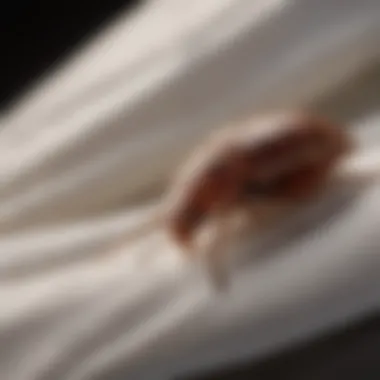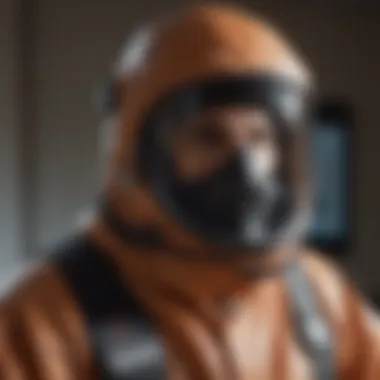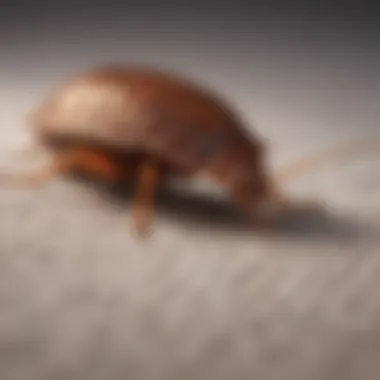Protective Clothing for Bed Bugs: A Comprehensive Guide


Intro
The management of bed bug infestations has become increasingly crucial for homeowners. The presence of these pests can lead to significant discomfort and anxiety. Protective clothing plays a vital role in this management strategy. When dealing with an infestation, the appropriate attire can minimize the risk of bites, ensuring safety for both homeowners and pest control professionals. This article will delve into protective clothing options, effective materials, and best practices. It aims to clear up any misconceptions surrounding bed bug transmission while providing practical advice to enhance safety and efficacy during pest control efforts.
Pest Identification
Understanding pests is the first step in effective control. Bed bugs, scientifically known as Cimex lectularius, are not the only pests that can invade homes. It is helpful to recognize common household pests.
Common Household Pests
- Cockroaches: Typically thrive in warm and humid areas.
- Ants: They form colonies and can invade food sources.
- Termites: Known for their destructive behavior, targeting wood in structures.
- Rodents: Mice and rats can enter homes through small openings and contaminate food sources.
Signs of Infestation
Detecting bed bugs requires vigilance. Here are the well-known indicators:
- Bite Marks: Often appearing in clusters on the skin.
- Blood Stains: Small red spots on bedding after the bugs feed.
- Dark Specks: These are bed bug excrement found on sheets or walls.
- Shell Casings: As bed bugs grow, they shed their skin.
"Timely identification of pests is key to successful management."
Recognizing these signs early ensures prompt action, reducing the complexity and cost of eliminating a pest problem.
Prevention Methods
Effective pest control begins before an infestation occurs. Certain environmental modifications can deter bed bugs and other pests.
Environmental Modifications
- Declutter: Reducing clutter gives insects fewer hiding places.
- Seal Cracks: Small openings in walls and around windows should be sealed.
- Use Screens: Install screens on doors and windows to prevent pests from entering.
Home Maintenance Tips
Routine maintenance can also enhance a home's defenses against bed bugs:
- Regular Cleaning: Frequent vacuuming can help eliminate potential pests.
- Monitor Shared Spaces: Pay attention to places like laundries; they can be hotspots for transmission.
- Inspect Furniture: Regularly check for signs of infestation, especially in second-hand items.
End
Protective clothing is not merely a precaution—it's a fundamental aspect of effective bed bug management. By identifying pests accurately and implementing preventive measures, homeowners can significantly reduce their risk of encountering these unwanted guests. This article has outlined the critically important role of protective apparel and provided detailed guidance to ensure a thorough and informed approach to managing bed bug issues.
Understanding Bed Bugs
Bed bugs are small, parasitic insects that feed on the blood of humans and animals. Understanding their biology and behavior is essential for effective management and treatment of infestations. Knowing how these pests operate makes it easier to apply protective measures, including the use of appropriate clothing.
Biology and Behavior
Bed bugs belong to the Cimicidae family. They are nocturnal and typically hide in cracks and crevices during the day. The adult bed bug is around the size of an apple seed, measuring approximately 4 to 5 mm in length. Their body is flat, which allows them to hide in tiny spaces. The eggs, which are about 1 mm in size, can be found in the same hiding spots as the adults.
Bed bugs are attracted to warmth and carbon dioxide, making sleeping humans prime targets. They can go long periods without feeding, some even up to a year, which complicates the eradication of infestations. Their feeding process involves piercing the skin to suck blood, often resulting in itchy welts that can lead to allergic reactions in some individuals.
Signs of Infestation
Identifying the signs of a bed bug infestation is crucial for taking timely action. Common indicators include:


- Bite Marks: Red, itchy welts typically appear on exposed skin after a bed bug has fed.
- Dark Spots: Small dark spots, which are bed bug excrement, may be found on sheets or mattresses.
- Eggs and Shedding: The presence of tiny, pearly white eggs or shed skin can indicate an infestation.
Regular checks in sleeping areas will help in identifying these signs early, thereby reducing the risk of a larger issue.
Health Risks Associated with Bed Bugs
While bed bugs are not known to transmit diseases, their presence can result in health complications. The most immediate concern is the discomfort associated with their bites. This discomfort can lead to:
- Allergic Reactions: Some individuals may have allergic reactions that can result in significant swelling or itching.
- Secondary Infections: Scratching the bites can lead to infections due to bacteria entering through the skin.
It is important to take infestations seriously, not only for physical health but also for mental well-being. The stress and anxiety caused by realizing that one's home is infested can be substantial, leading to insomnia and other psychological effects.
The Importance of Protective Clothing
Protective clothing plays a vital role in the management of bed bugs. As infestations can pose significant challenges, having appropriate gear is essential for both pest control professionals and homeowners. This section will elucidate why protective clothing is critical, emphasizing the benefits and considerations that come with its use.
When dealing with bed bugs, being proactive is key. Protective clothing acts as the first line of defense against bites. Bed bugs are adept at hiding and can quickly latch onto clothing. Using specific materials designed to repel or contain these pests can minimize direct exposure, thus reducing the risk of bites. Moreover, during treatments where chemicals are applied, protective gear can prevent any skin contact with potentially harmful substances. The right clothing not only provides physical barriers but also enhances the efficacy of pest management strategies.
Rationale for Protective Measures
The rationale behind employing protective measures can be grouped into several categories:
- Physical Protection: Bed bugs are small and can easily attach to clothes. Wearing protective clothing can create a barrier, preventing them from reaching the skin.
- Psychological Assurance: Knowing that one is adequately protected can reduce anxiety. This is particularly meaningful for individuals who may have had traumatic experiences with infestations.
- Reducing Contamination: Protective clothing can minimize the risk of spreading bed bugs from infested areas to non-infested spaces.
The effectiveness of protective measures often depends on the type of clothing worn. Clothing should be tight enough that bed bugs cannot crawl in between the fabric fibers. Materials with tightly woven threads are preferable, as they can offer better protection by preventing bed bugs from penetrating through.
Historical Context of Pest Management Clothing
Understanding the historical context of pest management clothing provides insights into its evolution and significance. In earlier pest control methods, protective gear was minimal. Workers often relied on long sleeves and basic wear to minimize exposure. However, as pest resistance and infestations grew, so did the need for improved protective measures.
In the 20th century, the advent of synthetic fibers led to advancements in protective clothing. Fabrics like polyester and nylon became popular due to their durability and resistance to wear and tear. Furthermore, the acknowledgment of the risks associated with chemical exposure required the integration of specialized materials that could withstand various treatments.
Today, the development of innovative textiles continues to revolutionize protective clothing. Modern solutions include garments that have built-in antimicrobial properties. This enhances both safety and comfort, which are critical for individuals frequently handling or exposed to bed bug situations. As our understanding of pest control grows, so does the need for suitable protective attire, reflecting a history of adaptation and progress in the field of pest management.
"Protective clothing is not just a choice, but a necessary measure in preventing bed bug infestations from becoming widespread."
Materials Used in Protective Clothing
Protective clothing serves as the first line of defense against bed bugs, a pest known for its resilience and ability to provoke health concerns. The materials selected for such clothing can significantly impact its effectiveness in preventing bites and facilitating safe pest management. When choosing protective apparel, several factors come into consideration, including fabric types, durability, and resistance properties.
Types of Fabrics and Their Effectiveness
The effectiveness of protective clothing largely depends on the types of fabrics used. Specific materials offer varying degrees of protection against bed bugs. Common fabric choices include:
- Polyester: This synthetic fabric is both lightweight and durable, making it a popular option. Its tight weave helps in minimizing the chance of bed bugs getting through.
- Cotton: While comfortable, cotton is not as effective in providing a barrier against bed bugs due to its looser weave. Nonetheless, it's often used for inner layers where breathability is a priority.
- Nylon: Similar to polyester, nylon is tough and resilient. It provides a higher level of resistance against potential punctures and damages, thus making it a preferred choice in protective clothing.
- Laminated Fabrics: Some protective clothing incorporates laminated fabrics, which feature a waterproof and breathable membrane. These fabrics not only help keep bed bugs at bay but also allow moisture to escape, maintaining comfort during extended use.
Choosing the right fabric is crucial for effectiveness. It’s important to remember that woven materials generally provide better protection than knitted fabrics.
Durability and Resistance Properties
Durability and resistance are critical characteristics of protective clothing. Both factors direct influence the lifespan and effectiveness of the apparel. Each material entails specific properties that determine its ability to withstand wear and potential bed bug penetration.
- Tear Resistance: Bed bug management often involves movement and labor. Therefore, the clothing should resist tearing, which might expose the skin to bites. Nylon typically has excellent tear resistance.
- Water Resistance: While not directly correlated to bed bugs, water resistance can enhance durability. Fabrics with water-resistant coatings resist stains and remain functional longer under various conditions, crucial for pest control activities.
- Wear Resistance: The daily tasks performed by pest control professionals or house owners can wear down clothing materials, making it important to select fabrics designed for high performance and long use.


Maintaining these properties helps ensure that protective clothing continues to serve its purpose effectively. Regular inspection and proper cleaning are vital to sustaining the durability of these materials.
An informed choice regarding materials helps both professionals and homeowners feel secure in their efforts to combat this growing concern. Understanding fabric types and resistance properties will empower individuals facing potential bed bug infestations.
Best Practices for Protective Clothing Use
The use of protective clothing in pest management is vital in preventing bed bug infestations from spreading and ensuring safety during treatment processes. Knowing when and how to wear this clothing, along with proper maintenance, can enhance its effectiveness. In this section, we will explore essential practices regarding protective clothing for bed bug control, including optimal wearing times, how to correctly equip oneself, and care instructions to uphold the apparel's durability.
When to Wear Protective Clothing
Understanding the right moments to don protective clothing is essential for achieving maximum safety and effectiveness. Here are instances when wearing protective clothing is not just advisable but crucial:
- During Treatment Procedures: Whenever pest control professionals are applying pesticides or engaging in extensive cleaning, protective clothing prevents direct contact with hazardous substances.
- While Handling Infested Items: If you are sorting through items that may contain bed bugs, such as clothing or bedding, wearing protective clothing shields you from potential bites.
- After Confirming an Infestation: As soon as you suspect or confirm a bed bug presence, equipping yourself can help minimize the risk of spreading the bugs to other areas of your home.
How to Properly Equip Yourself
Properly donning your protective clothing plays a significant role in its efficacy. Here are key steps to guide your preparation:
- Select the Right Gear: Choose clothing that covers your entire body. Long sleeves, pants, and closed shoes are essential. Avoid loose-fitting clothes that can create gaps for bugs to crawl through.
- Use Additional Barriers: Incorporating gloves and face masks can provide added protection against bites and pesticides. When dealing with highly infested areas, consider goggles or face shields to protect your eyes.
- Secure Your Attire: Ensure all clothing items are tightly secured. Knots, Velcro, or elastic bands can help achieve a snug fit at openings, such as cuffs and collars, where bed bugs might enter.
Maintenance of Protective Apparel
Taking care of your protective clothing sustains its effectiveness. Regular maintenance also ensures longevity, which is necessary for any pest control effort. Here are important maintenance tips:
- Regular Washing: Always wash your protective clothing after each use. High temperatures kill bed bugs and their eggs effectively.
- Inspect for Damage: Before using your attire, check for rips or tears. Any holes should be repaired promptly to maintain full coverage against bites.
- Store Properly: Keep protective gear in a sealed bag when not in use. This practice limits the risk of bugs infesting your clean clothing.
Properly equipped individuals reduce their risk significantly during bed bug treatments, making it a fundamental step in pest management.
By adhering to these best practices in protective clothing use, homeowners and pest management professionals can ensure a safer and more effective approach when tackling bed bug infestations.
Common Misconceptions Regarding Bed Bugs
Understanding the common misconceptions surrounding bed bugs is essential for effective management and prevention. Many people carry false beliefs about how bed bugs operate, which can lead to inadequate measures against infestations. This section aims to clarify these misleading notions, making bed bug management more informed and effective.
Transmission Myths
A prevalent myth is that bed bugs can jump or fly from one host to another. In reality, bed bugs cannot leap. Instead, they are adept at crawling and can travel short distances by moving across surfaces. This misconception often leads to the assumption that bed bugs are difficult to eliminate since they seem to appear out of nowhere.
Additionally, there is a belief that bed bugs can only be found in dirty or unsanitary conditions. While poor hygiene can contribute to infestations, bed bugs do not discriminate based on cleanliness. They are attracted to warmth and carbon dioxide, making any environment a potential habitat, regardless of its cleanliness.
In fact, high-profile hotels and residences have reported bed bug incidents, indicating that cleanliness is not a safeguard. It is crucial for homeowners and pest control professionals to recognize these myths for effective prevention strategies.
Understanding Resistance to Treatment
Another misconception is the belief that all bed bug treatments are equally effective. In reality, some bed bug populations have developed resistance to common insecticides, making treatment more complex. Understanding this resistance is key for proper pest management.
Resistance can stem from an increase in pyrethroid use, a common class of pesticides. Bed bugs may breed and proliferate, passing down these resistant traits. This creates a challenging situation for pest control efforts. It’s important to utilize an integrated approach rather than solely relying on chemical solutions.
- Combining heat treatment with chemical control can yield better outcomes.
- Regular inspection and monitoring for bed bugs help detect infestations early, before they escalate.
Addressing the misconceptions about transmission and treatment resistance reduces confusion and allows for more effective strategies against bed bug infestations. Knowledge is a powerful tool in safeguarding homes from these persistent pests.
Legal and Occupational Safety Considerations


Addressing legal and occupational safety considerations in pest control is a crucial aspect often overlooked by homeowners and pest management professionals. Understanding these elements ensures compliance with relevant laws, promotes worker safety, and enhances the effectiveness of pest control strategies, particularly for bed bug infestations. By recognizing the significance of these provisions, individuals can better protect themselves while tackling pest issues in their homes.
Regulations in Pest Control Practices
Pest control practices, especially in the context of bed bug management, are governed by several regulations designed to protect both humans and the environment. These regulations vary by region but typically include licensing requirements for pest control operators, safe handling of pesticides, and adherence to specified application techniques.
In many areas, pest control companies are required to register their products with regulatory agencies such as the Environmental Protection Agency (EPA) in the United States. This process verifies that the chemicals being used are safe for the environment and public health when applied correctly. Moreover, specific training programs must be completed by professionals, ensuring that they understand how to minimize risks associated with pesticide use.
orned industry standards also dictate the appropriate protective clothing that operators should wear during the application of pest control treatments. This is important not just for compliance, but also for minimizing the potential for exposure to harmful chemicals.
Safety Standards for Protective Apparel
Safety standards for protective apparel are essential in fostering a safe working environment for those involved in pest management. Proper clothing acts as a barrier between the human body and potentially hazardous materials, including chemicals used for pest control and bites from pests like bed bugs.
Regulatory bodies such as OSHA (Occupational Safety and Health Administration) provide guidelines for the design and use of protective clothing. For example, garments should be made of materials resistant to punctures and tears, as well as allow for proper ventilation to reduce heat stress during use.
In addition, it is important for attire to be fitted correctly. This means ensuring no excess material is present that could catch on objects or equipment. A snug fit helps keep chemicals from seeping through and maintains comfort during operation.
Understanding these safety standards not only promotes occupational safety but also enhances the efficacy of treatment practices. By adhering to regulations, pest control operators and homeowners can engage in bed bug management with a heightened sense of security, knowing they have taken the necessary precautions to protect themselves from bites and chemical exposure.
"Adhering to legal regulations and safety standards protects the health of operators and enhances the effectiveness of pest control measures."
In summary, the legal and occupational safety considerations surrounding pest control are vital. They ensure safer environments for both pest management professionals and homeowners while promoting effective control practices. It is essential to stay informed about local regulations and adhere to the established safety protocols when managing bed bug infestations.
Advancements in Protective Clothing Technology
Advancements in protective clothing technology have transformed the landscape of pest management, particularly in dealing with bed bugs. As the understanding of these pests evolves, so too does the need for enhanced protective measures. Technology in clothing design now incorporates innovative materials and functionalities that address the specific challenges faced during bed bug infestations. These enhancements not only mitigate the risk of bites but also improve the overall comfort and efficacy of the garments worn during treatment.
Innovations in Fabric Technology
Recent advancements in fabric technology have introduced materials that are both durable and resistant to bed bug penetration. Fabrics such as breathable polyester blends, which are often used in protective clothing, provide a barrier against pests while allowing for ventilation. This is crucial for long periods spent in infested areas.
Moreover, some fabrics are treated with insect-repellent chemicals, enhancing their protective quality. The incorporation of microfibers in these textiles also plays a role in preventing bed bugs from latching onto the surface. This is vital as bed bugs are known for their ability to cling onto clothing and easily transfer to other environments.
In addition, enhanced durability means these materials can withstand multiple wash cycles without losing their integrity or effectiveness. Homeowners and pest control professionals can thus rely on protective clothing for repeated use without compromising protection.
Future Directions in Protective Clothing Design
Looking ahead, the future directions in protective clothing design are poised to focus on functionality and user experience. There is an increasing trend towards customizable protective apparel that fits different body types comfortably. This is important as an ill-fitting outfit may leave gaps that bed bugs could exploit.
Additionally, the integration of smart technology within protective clothing represents a significant shift. For instance, garments could feature embedded sensors to detect the presence of bed bugs, alerting the wearer and allowing for immediate action. This could be particularly useful for professionals in fields that frequently deal with pest management.
Innovations may also lead to clothing that incorporates antimicrobial properties, reducing the likelihood of secondary infections from bites. Furthermore, sustainability will play a role in future designs. Eco-friendly materials that provide effective pest protection while being gentle on the environment will likely become more prevalent.
"The evolution of protective clothing is not merely a response to bed bug infestations but a proactive embrace of technology in pest management."
Ultimately, these advancements not only enhance the protection against bed bugs but also improve the overall pest management experience for homeowners and professionals alike. The ongoing development in protective clothing technology signifies a crucial step towards more effective and safer pest control practices.
Finale and Recommendations
In addressing the pervasive issue of bed bug infestations, the importance of protective clothing cannot be overstated. This article has illuminated how specific apparel acts as a barrier against bites and contamination during treatment. It is critical to select appropriate protective clothing to enhance safety and efficacy in pest management. Furthermore, understanding the right materials, maintenance practices, and contexts for use represents a significant advance in combating these resilient pests.
Protective clothing, such as specialized suits and gloves, significantly minimizes the risk of direct contact with bed bugs. The rationale is straightforward: by creating a physical barrier, one can reduce the chance of initiating an infestation or worsening an existing one. The benefits are twofold—first, they protect the wearer from potential bites and second, they help to prevent the spread of these pests to non-infested areas.
Summary of Essential Points
- Protective clothing serves to shield against bed bug bites, which can cause discomfort and various health issues.
- Selecting the right materials for protective clothing is essential, as specific fabrics can enhance resistance to bites.
- Proper maintenance of apparel ensures longevity and efficacy in protection against bed bugs.
- Timing of use is crucial; specific situations such as inspections and treatments warrant appropriate protective attire.
- Common misconceptions regarding bed bug transmission are addressed, emphasizing the need for informed decisions in pest management.
Final Thoughts on Protective Clothing in Pest Management
The takeaway from this discussion is that informed choices regarding protective clothing can significantly influence the success rates of bed bug control efforts. Homeowners and pest control professionals alike must prioritize protective measures to ensure not only their safety but also the effective eradication of these pests. Continuing advancements in fabric technology hint at a future where protective measures will become even more sophisticated, proving that a proactive approach in pest management is essential. As bed bug encounters remain prevalent, an ongoing commitment to learning about and implementing effective protective strategies will continue to benefit those affected.















